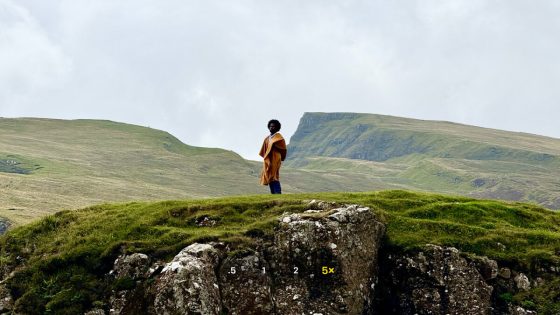Learn more:
iPhone 15 Pro Max telephoto lens specs
- 2X digital crop
- 12MP, 5.0x optical zoom, 120mm, ƒ/2.8, OIS
Technically, the new camera is not a periscope. Periscope lenses typically reflect light 90 degrees from a mirror and through multiple lenses before it reaches the sensor, taking up more space. In contrast to this, Apple used a tetraprism, a folded glass structure under the lens, which refracts light rays four times before they reach the sensor. This saves space and also allows the camera to benefit from a much faster aperture compared to traditional periscope lenses.
Although it reaches a maximum of 5 times optically, the iPhone 15 Pro Max can provide up to 25x total zoom. Yet this only represents a quarter of the potential zoom that the Galaxy S23 Ultra can deliver, as Samsung’s best phone so far maxes out at 100x. It is so far the phone with the most advanced zoom on the American market.
Galaxy S23 Ultra Telephoto/Periscope Camera Specifications
- 2X digital crop
- 10MP 3.0x optical zoom, 69 mm, 1/3.52″ sensor, 1.12 μm pixels, ƒ/2.4, PDAF, OIS
- 10MP 10.0x optical zoom, 230 mm, 1/3.52″ sensor, 1.12 μm pixels, ƒ/4.9, PDAF, OIS
The 10x periscope camera Galaxy S23 Ultra delivers extremely good results in broad daylight, but struggles a bit in dimly lit environments due to its slow f/4.9 aperture. Ch
Once you go past the 10x optical zoom setting in the Camera app, image quality regresses, so anything above 10x mode is discouraged.
Apart from the 10x optical zoom lens, the big news with the Galaxy S23 Ultra is its impressive new 200 MP main camera. Of course, like most high-megapixel phones, the Galaxy S23 Ultra uses pixel-binning to combine sixteen pixels into one and produce photos with less noise and better low-light sensitivity.
iPhone 15 Pro Max against Galaxy S23 Ultra: Zoom comparison
Scene 1
In our first scene, both phones did a decent job capturing our model in the best possible light. At 2X, while decently detailed and exposed, both photos show some minor noise, but nothing too overwhelming. At 3X, the Galaxy’s first telephoto lens comes into play and delivers an optically superior result compared to the iPhone, which lacks detail in its 3X photo example. At 5X, however, the iPhone makes up lost ground with more detail and an overall better-looking photo. However, when we zoom in to 10X, which is the Galaxy’s strong point thanks to the dedicated periscope, the Galaxy clearly outperforms the iPhone 15 Pro Maxwhich shows a lot more noise-related artifacts and a general lack of finer detail.
Scene #2
The same general conclusion is true for our second scene, in which our subjects look mostly similar at 2X with either phone, but the Galaxy generally dominates at 3X and 10X, while the iPhone films decidedly better at 5X.
Scene #3
In this scene, the Galaxy struggles at 5X, with the text on the billboards in the background barely noticeable, unlike the iPhone, which scored another major victory thanks to the dedicated 5X telephoto camera. At 10X, the Galaxy is naturally better in terms of detail reproduction, but surprisingly the iPhone doesn’t lag behind either, even though it’s already out of its comfort zone when it comes to optical zoom.
Scene #4
With perfect afternoon lighting, the Galaxy is once again optically superior at 3X and 10X, while the iPhone has the upper hand in the 5X zoom range. However, the differences aren’t that big even at 10X, where some may even prefer the iPhone’s photo.
Scene #5
When you flip the switch and the light goes off, things aren’t very exciting for either phone. At 3X, the Galaxy delivered a much better night photo that looks the part, with richer colors and better dynamics. Meanwhile, the iPhone gives us a darker, moodier scene, with some bonus lens flare. At 5X the situation is balanced, with both phones providing mostly similar (and unappealing) photos. However, finer details look better on the iPhone. At 10X, the Galaxy smoothed out some details, while the iPhone dumped a bucket of blurry noise across the entire sample image.
Scene #6
In contrast, in this second low-light scene, when the lighting is even more extreme and generally limited, the much narrower aperture of the Galaxy’s periscope camera struggled to capture the scene in a timely manner, resulting in leads to motion blur. and lack of finer details. At the same time, the iPhone 15 Pro MaxThe tetraprism telephoto lens helped it beat the Galaxy in this task test thanks to the wider (faster) aperture.
Scene #7
In our final scene, the differences couldn’t be more pronounced: an iPhone victorious in the 5X range, where the Galaxy struggled. The 10X test in this scene is a very close victory for the Galaxy despite its smudged details; the noise on the iPhone is just too much to handle.
Conclusion
And there you have it: each of these phones surely excels in the discipline in which it is best versed! Due to hardware differences, you can’t really have an “apples to apples” comparison where each phone’s dedicated zoom camera goes against the other’s dedicated camera, and vice versa. Most scenes had to include optical or digital zoom due to different spec sheets.
Generally, the iPhone excels at 5X, while the Galaxy is better at 3X and 10X, which was the logical conclusion to expect from the start. But again, in good lighting conditions, the differences aren’t that stark when it comes to detail and overall resolution; it’s the image processing, dynamic range, and color science specific to Samsung and Apple that make the biggest difference.
In low light, the differences are a little more pronounced, and the slow aperture of Samsung’s periscope begins to show its biggest weakness: low-light photography. In such conditions, the iPhone easily matches the Galaxy S23 Ultra.
















